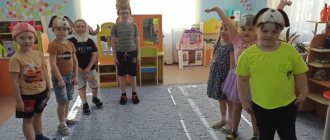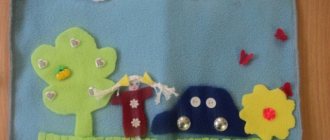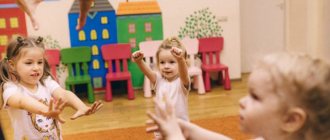Self-massage and mutual massage
Equipment: small massage balls to activate body points; massage mats; Su-jok; drawings and tables on acupressure self-massage; gymnastic balls.
Body massage
Goal: to teach children self-massage skills; develop teamwork skills; consolidate knowledge of body parts; practice the ability to warm up your body.
Progress of the lesson.
1. Warming massage.
Stroking
Children sit cross-legged on the rug. At the beginning of the lesson, warm up your palms, rubbing them together, then gently stroke your neck from the cervical vertebrae to the larynx (6-8 times). During the break between strokes, slowly turn the head to the right and left. Next, children stroke their arms from hand to shoulder. Accompany the actions with the words: “From hand to shoulder.” Then they also stroke the legs one by one, accompanying the actions with the words: “From foot to thigh.”
Rubbing and patting
Children begin rubbing from the neck, then arms and legs, legs, thighs. Children clap with their hands. It is necessary to draw children's attention to the fact that patting the soft tissues of the hands and feet should be tangential. At the final stage, children stand on their feet and warm them up by rubbing them one by one on the carpet.
2. Couples massage.
Children are invited to choose a pair and position for performing the massage. You can use gymnastic balls (one child lies on the ball, the other, standing, massages it). You can choose a lying position on the floor (one child lies, the other does a massage, sitting astride or kneeling nearby).
Description of massage:
- warming up your palms;
- stroking (from shoulder to lower back);
- rubbing (alternately with palms, herringbone pattern);
- stroking;
- play massage (“The chicken pecked”, “The geese nibbled”);
- stroking;
- game exercise with vocalization while exhaling (sound “a”) “The elephant has passed.” With the soft side of their fist, children tap on their friend’s back. From the shoulders to the middle of the back and back to the shoulders. A lying child says “a” as he exhales.
- stroking.
Then the children change places and the massage continues with other children.
The assessment of task completion is given based on the condition of the skin.
Acupressure of hands and body
Daily self-massage and mutual massage (massage to a friend) of the hands and body after a nap.
Option 2
— We received a new letter from Pilyulkin, with drawings. He tells us that guys, we also have “magic points” on our bodies that will also help us cope with Queen Cold and Princess Bad Mood. Let's look at these drawings and find these points from each other (children look at the drawings together, in pairs they study the points on a friend's body, on their own body). By gently massaging each point ten times every day, we will become strong and resilient. But remember, it is important that your touches are gentle and pleasant to your friend, only then the “magic points” work.
Formation of moral health of preschool children: Activities, games, exercises / Ed. L. V. Kuznetsova, M. A. Panfilova. - M.: TC Sfera, 2003. - 64 p. pp. 19-22.
Rules for performing self-massage
Before performing articulatory self-massage, it is necessary to check the cleanliness of the baby’s hands and face. It is advisable that the child have a clean handkerchief (preferably a disposable one), because sometimes excessive salivation accompanies the performance of certain exercises. Contraindications to self-massage are open wounds on the massaged area. It is better if the baby does articulatory self-massage in front of a mirror. The only thing you need to remember is that the child needs to perform self-massage for 7-10 minutes, without causing any discomfort. Each movement must be repeated 4-6 times. It is good if, when performing exercises, the child hears speech accompaniment in poetic form or calm music.
Self-massage techniques
When performing self-massage, a number of techniques are used: stroking, rubbing, pressing, pinching, passive movements, flexion, extension of the fingers.
The simplest and most important technique of self-massage is stroking. Calming effect on the nervous system. Improves muscle and gland function. In restorative self-massage, this technique is performed for increased nervous excitability, and in therapeutic self-massage, for spasms, injuries, etc. Stroking can be linear or circular.
Kneading is a self-massage technique that massages muscles. Under the influence of kneading, the speed of blood flow significantly improves, which contributes to the rapid restoration of mental and physical performance.
A special massage technique is rubbing. It differs from other techniques in its more energetic execution in various directions. Rubbing can be: - straight, zigzag, spiral and circular rubbing with the pads of one or more fingers and the tubercles of the thumbs; - straight rubbing with forceps; - straight rubbing with the base of the palm; - comb-like rubbing with fingers clenched into a fist. During rubbing, local blood circulation improves, tissues warm up, the resorption of hardening accelerates, muscle plasticity increases and performance increases.
Passive movements are performed only after kneading the muscles and rubbing the joints. Usually passive movements are performed with outside help.
Children are first introduced to self-massage techniques in speech therapy classes. You can teach children self-massage techniques from 2-2.5 years old. The training takes place in a playful way; children are asked to imitate various animals or objects (for example, a monkey). If desired, any parent can teach their baby to perform self-massage.
The positive effect of self-massage
“Massage of the articulatory apparatus and articulatory exercises not only improve the motor function of lagging brain systems, but also involve nearby brain systems in their work.” M. E. Khvattsev
As a result of regular self-massage in children, the muscle tone of the articulatory apparatus is normalized (in the most difficult cases, the degree of manifestation of defects in the articulatory muscles decreases); those muscle groups that were not sufficiently included in the pronunciation process begin to work; the organs of articulation are ready to form voluntary, coordinated movements and to produce defective speech sounds; hypersalivation decreases. The advantages of self-massage also lie in the fact that children enjoy doing it and therefore parents can easily repeat the self-massage procedure several times a day, performing various exercises. In speech therapy classes, these exercises are performed simultaneously with several children, which creates a certain competitive element and promotes a sense of community.
What is self-massage?
Self-massage is a combination of stroking, rubbing, kneading and vibrations that a person performs on the surface of his body. Self-massage in speech therapy practice is divided into 3 types: general (self-massage of the head, neck, torso), articulatory (self-massage of the lips, cheeks and tongue) and finger massage.
Any self-massage cannot do any harm, and its benefits are obvious. It trains blood vessels and promotes better oxygen supply to internal organs. By doing self-massage, a child strengthens the muscles of the hands and fingers, relieves muscle tension, and kneads one or another part of the body or face.
Another advantage of self-massage is its accessibility: you don’t have to go anywhere and change your routine, and you can do it at any convenient time.
Regular self-massage and adult supervision over its correct implementation are important.





